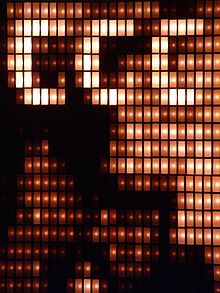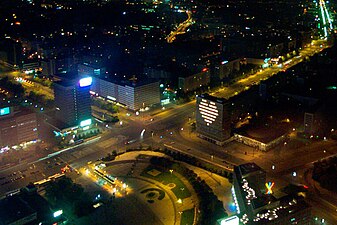This article has multiple issues. Please help improve it or discuss these issues on the talk page. (Learn how and when to remove these messages)
|
52°31′16.9″N 13°24′58.6″E / 52.521361°N 13.416278°E / 52.521361; 13.416278

Project Blinkenlights was a light installation in the Haus des Lehrers building at the Alexanderplatz in Berlin that transformed the building front into a giant low-resolution monochrome computer screen. The installation was created by the German Chaos Computer Club (CCC) and went online on 11 September 2001 as a celebration of the club's 20th birthday. Some novel uses of the screen are for people to call a number and play Pong via mobile phone or display animations sent in by the public.
Similar installations were created by the CCC for the Bibliothèque nationale de France in Paris in 2002 (called Arcade) and for two towers of the City Hall in Toronto (called Stereoscope). Both installations feature higher resolutions and eight shades of grey.
The electrical engineering and computer science students of the Budapest University of Technology and Economics turn their Schönherz Dormitory into a giant display ("the Matrix") at their annual Schönherz Cup competition, where amongst others, teams compete to create the most interesting and funny animations.
A similar display, featuring three colours, is annually created by students of Wrocław University of Technology and the University of Bordeaux, who have released open-source software to create interactive architectural displays.
Independently, an installation displaying the message "FERTiG" (German for "FINISHED") was shown at the completion of the Elbphilharmonie in Hamburg in 2016.
In August 2023 a new Installation was shown on the CCCamp in Mildenberg. It was called Polychrome and used RGBw LED which have been calibrated as Tim Pritlove shown in a Talk about the Project on Aug. 16.
The term "blinkenlights" originates in hacker humor. One of the CCC installations is depicted in the Golden Boy and Miss Kittin video for their song "Rippin Kittin".
-
 Aerial view of Project Blinkenlights in Berlin
Aerial view of Project Blinkenlights in Berlin
-
 The Elbphilharmonie "Fertig" message
The Elbphilharmonie "Fertig" message
-
 Project Pressure Voices For The Future, 2019
Project Pressure Voices For The Future, 2019
References
- "Project Blinkenlights | Project Blinkenlights". Blinkenlights.net. 2001-09-11. Retrieved 2013-09-01.
- "NUIT BLANCHE SUR LA BNF" (in French). Retrieved 2020-10-27.
- "P.I.W.O. Light Show | Potężny Indeksowany Wyświetlacz Oknowy". Piwo.pwr.wroc.pl (in Polish). Retrieved 2013-09-01.
- "Arbalet Frontage". hacketafac.u-bordeaux.fr (in French). 2017-08-28. Retrieved 2020-05-08.
- Golden Boy ft. Miss Kittin - Rippin Kittin (Glove Radiomix) on YouTube
External links
This article about German culture is a stub. You can help Misplaced Pages by expanding it. |